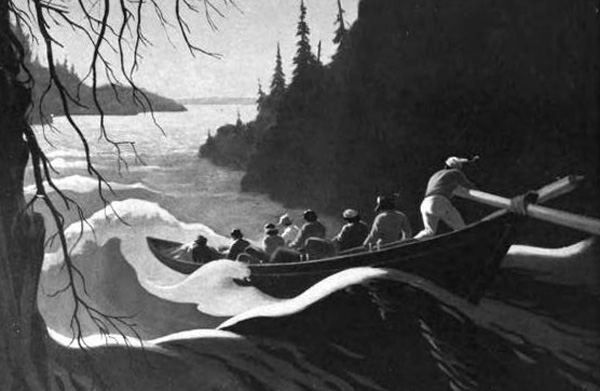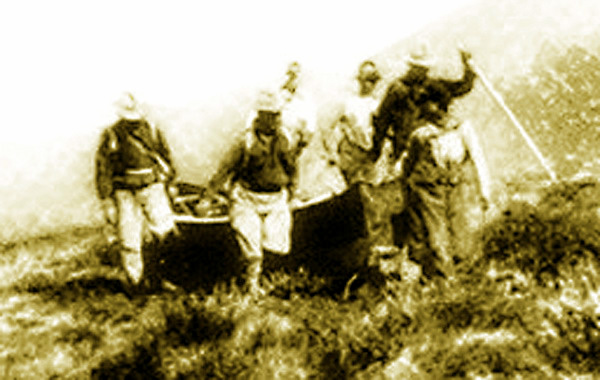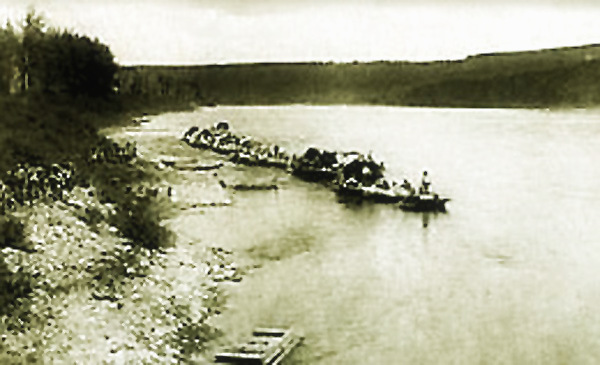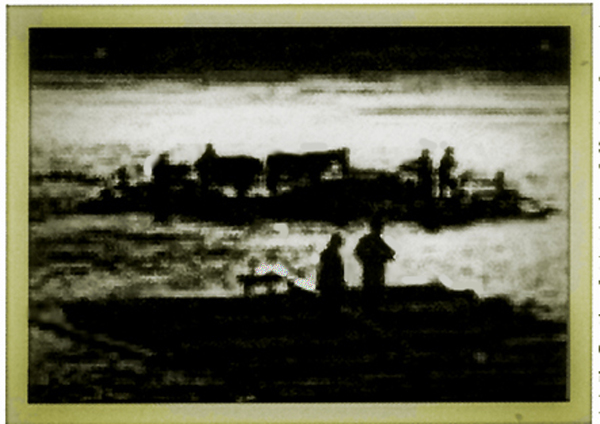
| From Wyoming Tales and Trails This Page: the Edmonton Trail to the Yukon, Byron F. Wickwire. |
 |

| From Wyoming Tales and Trails This Page: the Edmonton Trail to the Yukon, Byron F. Wickwire. |
 |
|
|
|
About This Site |
The Edmonton Trail from Edmonton to Dawson City. If Chilkoot Pass and White Pass were worse than the Australian tracks which in turn were worse that the Texas Trail, far, far, worse was the Edmonton Trail. In 1897 when the Gold Rush to the Yukon and the Klondike, the merchants of Edmonton saw the golden opportunity. Promotion of Edmonton as the entrance to the Yukon began. It was, promotional literature of the day repeated endlessly,the side door to the Yukon. Writers rushed into print extolling the virtues of the new gateway to the North. Well known writer charles Brampton came out with his "Klondike, A Manual for Gold Seekers."
Bramble's Guide was accepted by reviewers as authoritative. A reviewer for Literary World, Oct. 16, 1897, wrote:
[{W]e should commend his [Bramble's} book with confidence to the attention of those who wish further to study that subject. What a picture is presented of the region and the way to get there! It is but a single point in it that is presented in the statement that it is 2,500 miles from San Francisco to St. Michael‘s, and 1,895 miles from St. Michael’s to Dawson City. The summer weather is warm, but there are only three months of it. Mr. Bramble describes the country geographically and topographically, traces the various routes to get there, describes the life at the diggings and the methods of mining, sets forth the items of miners’ outfits, reviews the mounted police, rehearses the Canadian mining laws, warns against the prevalent diseases, and, in short, furnishes full information for all who are bound to go to this new Eldorado for themselves. A writer for the San Franciso Call> noted of Bramble and his Guide, "He knows whereof he spearks, and his advise contained in the book is well worth listening to." Branble in the Guide wrote of the Edmonton Trail: the route from Edmonton is so well defined, having been traveled for years, that no guides are required. “You don’t need a couple of thousand dollars to start for Klondike to-morrow by the Edmonton route. All you need is a good constitution; some experience in boating and camping, and about $150. Suppose a party of three decide to start. First, they will need to purchase a canoe, about $35 or less; first-class ticket from Hamilton to Edmonton, $70.40; second-class, ditto, $40.90; cost of food at Edmonton for three men for two months (should consist of pork, flour, tea and baking powder), $35; freight on canoe to Fort McPherson, $23. Total for three men from Hamilton to Fort McPherson, provided they travel second-class on the Canadian Pacific Railway (they can travel in a Pullman coming back), will be $218.70. These figures are furnished by Mr. [Arthur] Heming, who has been over the route 400 miles north of Edmonton, and got the rest of his data from the Hudson Bay officials.Forest and Stream, January 23, 1898, estimated that the trip from Edmonton to Pelly in the dead of winter on the ice could be made in only 90 days. In summary, the merchants of Edmonton stressed that the route out of Edmonton was the poor man's route. It was quicker. The outfits could be purchased in Edmonton thereby avoiding the payment of customs duties which had to be paid if coming in from Alaska. One could bring one's own horses which could be used when the Klondike was reached. In actuality there were two routes, the Peace River Route and a second by way of Athabasca Landing. The route recommended by Edmonton merchants was the former rwhich an from Edmonton to Fort Assinboine, North Slave Lake, Peace River Landing, across the Nelson River and along to the Frances River to Pelly, a distance of only 1,000 miles. It did not require a boat. Arthur Heming, on the other hand recommended the latter route requiring the use a vessel vessel similar to a "York Boat."
 York Boat, illustration by Arthur Heming.
 Portaging the Rat Summit.
The better financed prospectors would frequently used the Athabasca Route, among those was a former plice chief and mayor of Hamilton, Ontario, A. D. Stewart. He kept a diary of his adventure. On the journey he developed skurvy. His last entry was on February 14, 1899, "teeth al loose and gums very sore * * * in pitiable conditions." for the next several wees according to his companion as he worsened he drifting in and out of consiousness and expired on March 13. Later, In Robert W. Service, the Yukon poet, took the route using a canoe. On the trek, he wrote his famed "When the Ice-Worm Nests Again," words at bottom of page.  Boats at Athabascalanding.
On arriving in Edmonton, Wickwire discovered that conditions on the trail was somewhat hyped. North of town, there was no trail. The trail was miserable. Those taking it in the summer were subjected to great swarms of mosquitoes. Worse were the "bull-dog" flies, half again as big as bumblebees. They would follow the horses and drive them frantic. The bite of the flies was knife-like. Dogs fared little better. Gold Seekers following the trail reported the aroma of rotting horse flesh. Many discovered that rather than the three months for the crossing to the Yukon, it often took far longer if one made it at all. Writer Mae Haris Anson referred to the Edmonton Trail as the "Death Trail to the Yukon." See "Wheat is Wheat," Northwester Miller, Oct. 23, 1907. Novelist Elizabeth Page wrote an account based on the journey of B. F. Wickwire, "Wild Horses and Gold: From Wyoming to the Yukon;" Farrar & Rinehart (1932). A contemporary review in the Booklist. 1932, p. 70 referred to the book as an "actionized narritive." In the narritive Wickwire is renamed "Kansas Gilbert." Mrs. Page noted that on one occasion it took the herd twenty-eight days to go forty-eight miles. One gold seeker who was lured by the accounts of how easy it was to get to the Yukon over the Edmonton Trail complained that the advertisements were "most infernal swindle that ever was placed in front of the public." Another alleged pressed on rather than turn pack only because Hell could not be as bad. One might not be able to live off the land. The trail crossed the "Dog Eating Prairie," so called because Indians crossing it allegedly faced starvations and ended up eating their dogs. One prospector reported that it took from September 1897 until July 1899 to reach Dawson City. Some would construct cabins to winter over before moving on. In one cabin there were found two prospectors frozen solid. In the lump of ice in their cooking pot were found the remnants of two moccasins. At the height of the Gold Rush it was estimated that 2000 started out and only about 150 made it. Wickwire made it to Dawson with one horse remaining. The horse and Wickwire rode in on a boat.
 Left B. F. Wickwire, Above, Horses on raft on the Yukon River. Seventeen years later, Frank Gapen of Hyattville retraced in part Wickwire's trail north of Edmonton. He started out in March 1914 and sent back to the Big Horn Rusterler and account of his adventures. See Ruster March 26, 1914 and September 17, 1914. By September 17 he had reached Edmonton and was leaving for Athabaska Landing. 97 miles away. He recounted that on the way to Athabaska Landing he overtook a man with wife and seven children with one team who was stranded on the "accursed trail many miles from a house and just out of provisons. H provided food from his larger and lent him a spare team for his wagon. A few days later Gapen found the "mother mudhole. It took him a day and a half to get his wagon thirty feet. In December the (i> Rustler reported that he renewed his subscription writing from Peace Coupe, British Columbia. He promised more letters. No more were published.
Next Page, Cattle Ranches near Birney, The Three Circle.
|

